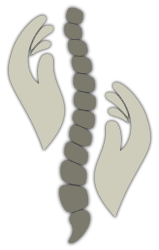Osteopathic treatment firstly treats the body as a whole. Osteopaths recognise that all structures in the body are connected and that dysfunction in one area will eventually affect another. For example, a lower back problem will tighten the gluteal muscles in the hip, which then connect to the outer thigh and can alter the mechanics of the knee.
Similarly, a foot, knee, hip or mid-back problem can affect your lower back. There are many, many connections and patterns like this that we deal with on a daily basis, but if the big-picture is kept in mind the problem can usually be resolved quickly.
Secondly osteopaths like to treat all of the tissues involved in the problem, including muscles, joints, connective tissue (ligaments and fascia as mentioned before) and if required the fluids of the body including blood flow, lymphatic flow and cerebrospinal fluid flow (see Cranial Osteopathy below).Techniques are wide-ranging and include:Muscles: Soft tissue massage, muscle energy technique (stretching with muscle activation), counterstrain (sustained pressure in a position of comfort).Joints: Articulation (gentle rocking), manipulation (either gradual pressure with breathing or a short, quick impulse to release a locked joint.Connective tissue: Balanced Ligamentous Tension (subtle movements to restore ligaments and joints to their correct tension or position), fascial and myofascial release (addresses the long strands of connective tissues that run through the body and blend it into one unit) Cranial Osteopathy: very gentle treatment that starts with the bones that make up the skull and extends into treating the fluids of the body. See ‘Cranial Osteopathy’ below. Osteopathic treatment is mostly gentle, but some people require (and some prefer) deep muscular work, which can be tender at times.
The treatment is tailored to each individual patient, so for example a treatment of a newborn baby or elderly patient will be much gentler than the tradesman with the very stiff lower back. However, we believe at Central Osteopathy that the minimum amount of pressure or force required to resolve an issue should only be used. If force from a fall or a bend too far, for example, has created a problem, more force can worsen the problem, but gently releasing the tissue restriction can resolve it. Two wrongs don’t make a right.
Get in Touch
At Central Osteopathy we treat all the tissues involved in a problem including muscles, joints and connective tissues so that the problem resolves quickly.

